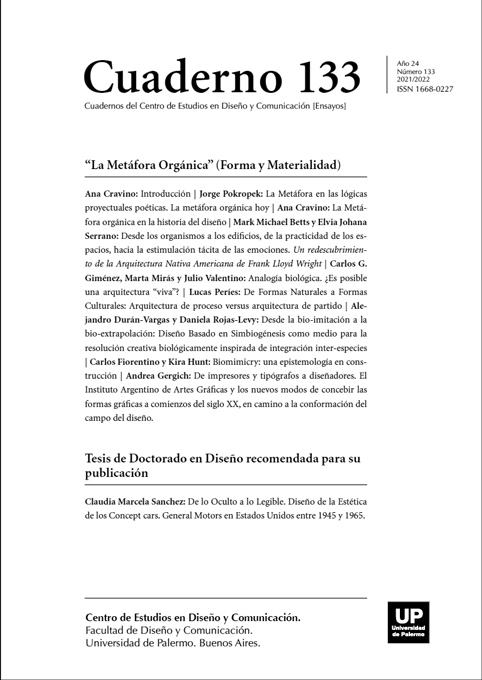Biomimicry: una epistemología en construcción
Abstract
Biomimicry is not considered a developed design discipline yet, even with a methodology and supporting theories well established. In most cases, biomimicry is only considered an emerging discipline. The epistemology of biomimicry is a project under development, a discipline under construction. This article proposes a brief review on conceptual and contextual aspects of biomimicry, a review on its methodological content, and an analysis of present and possible future of this emerging discipline.
References
Bejan, A. & Zane, J. (2012). Design in nature: How the constructal law governs evolution in biology, physics, technology, and social organization. New York, NY: Doubleday.
Bennett, J. (2010). Vibrant matter: A political ecology of things. Durham, NC: Duke University Press.
Benyus, J. M. (1997). Biomimicry: Innovation inspired by nature. New York, NY: Perennial.
Biomimicry 3.8 (2013). Life’s Principles g6, 2013, https://biomimicry.net/the-buzz/resources/designlens-lifes-principles/Biomimicry Institute, Biomimicry Taxonomy, 2008-2021, https://asknature.org/resource/biomimicry-taxonomy/
Carlson, R. (1961). Silent Spring. New York: Houghton Mifflin.
Fiorentino, C. & Montana-Hoyos, C. (2014). The Emerging Discipline of Biomimicry as a Paradigm Shift towards Design for Resilience. The International Journal of Designed Objects. Champaign, Illinois, USA: Common Ground Publishing LLC 8 (1) 2-15.
Fiorentino, C. (2012). Design for Sustainability vs. Design for Resilience: A Time Scale Problem? The International Journal of Sustainability Education 8, 30-45.
Fry, T. (2017). Design after design. Design Philosophy Papers, 15(2), 99-102.
Gibson, J. J. (1977). The theory of affordances. In R. Shaw & J. Bransford (Eds.), Perceiving, acting, and knowing: Toward an ecological psychology (pp. 67-82). Hillsdale, NJ: Lawrence Erlbaum.
Gibson, L. J.; Ashby, M. F. & Harley, B. A. (2010). Cellular Materials in Nature and Medicine. https://www.cambridge.org/us/academic/subjects/engineering/biomedical-engineering/cellular-materials-nature-and-medicine
Guba, E. G. (1990). The alternative paradigm dialogue. In E. G. Guba (Ed.), The paradigm dialogue (pp. 17-27). Newbury Park, CA: Sage.
Hawken, P. (1994). The ecology of commerce. New York, NY: Harper Business.
How, M. J.; Norman, M. D.; Finn, J.; Wen-Sung, Ch. and Marshall, N. J. (2017). Dynamic Skin Patterns in Cephalopods. https://www.ncbi.nlm.nih.gov/pmc/articles/PMC5474490/
Kant, I. (1999). Practical philosophy. Cambridge, UK: Cambridge University Press.
Kellert, S. R.; Heerwagen, J. & Mador, M. (2008). Biophilic design: The theory, science and practice of bringing buildings to life. Hoboken, NJ: Wiley.
Kennedy, E. B. & Marting, T. A. (2016). Biomimicry: Streamlining the front end of innovation for environmentally sustainable products. Research-Technology Management, 59(4), 40-48.
Leopold, A. (1970). A Sand County almanac: With other essays on conservation from Round River. New York, NY: Ballantine Books.
Lincoln, Y. S. & Guba, E. G. (2000). Paradigmatic controversies, contradictions, and emerging confluences. In N. K. Denzin & Y. S. Lincoln (Eds.), Handbook of qualitative research (2nd ed., pp. 1065-1122). Thousand Oaks, CA: Sage.
McIntosh, A. (2012). The challenge of radical human ecology to the academy. In L. Williams, R. Roberts, & A. McIntosh (Eds.), Radical human ecology (pp. 31-56). Surrey, UK: Ashgate.
Naess, A. (1973). The shallow and the deep, long-range ecology movement: A summary. Inquiry, 16(1-4), 95-100.
Ngoc San Ha & Guoxing Lu (2020). A Review of Recent Research on Bio-Inspired Structures and Materials for Energy Absorption Applications, https://www.sciencedirect.com/science/article/abs/pii/S1359836819339964v
Orr, D. (2002). The nature of design. New York, NY: Oxford University Press.
Sterba, J. P. (2011). Biocentrism defended. Ethics, Policy & Environment, 14(2), 167-169.
Taylor, P. W. (1983). In defense of biocentrism. Environmental Ethics, 5(3), 237-243.
Varela, F. G.; Maturana, H. R. & Uribe, R. (1974). Autopoiesis: The organization of living systems, its characterization and a model. Biosystems, 5(4), 187-196.
Wahl, D. C. (2016). Designing regenerative cultures. Axminster, UK: Triarchy Press.
Wilson, E. O. (Ed.). (1984). Biophilia: The human bond with other species. Cambridge, MA: Harvard University Press.
Woolley-Barker, T. (2013). How would nature create a “generous city”? Retrieved from http://www.triplepundit.com/2013/07/creating-conditions-conducive-life-firstbiomimicry-38-global-conference/
Los autores/as que publiquen en esta revista ceden los derechos de autor y de publicación a "Cuadernos del Centro de Estudios de Diseño y Comunicación", Aceptando el registro de su trabajo bajo una licencia de atribución de Creative Commons, que permite a terceros utilizar lo publicado siempre que de el crédito pertinente a los autores y a esta revista.


